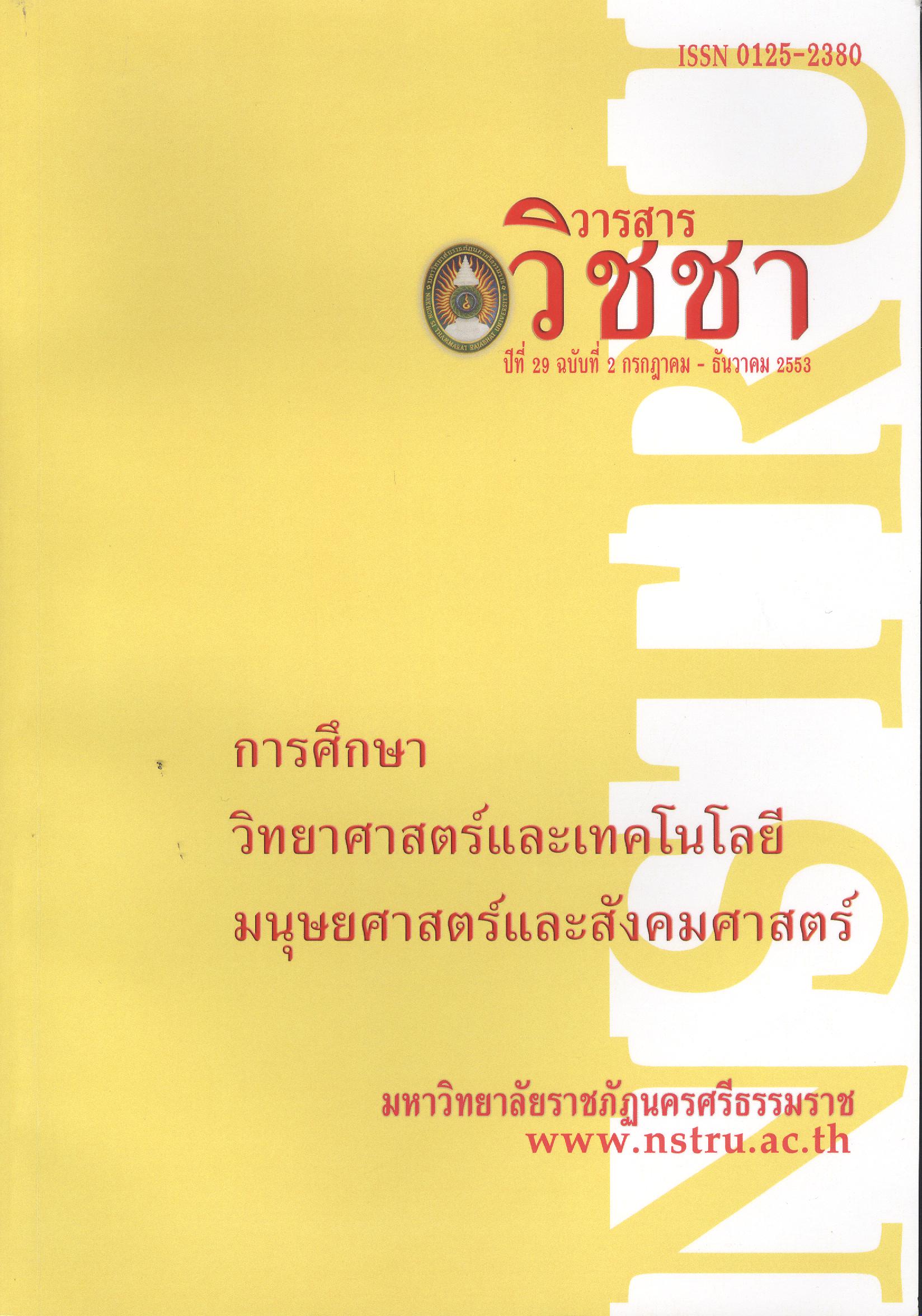ความปลอดภัยทางอาหารของทรัพยากรชีวภาพในชุมชนประมงอ่าวนครศรีธรรมราช
Main Article Content
Abstract
อ่าวนครศรีธรรมราช เป็นแหล่งทรัพยากรอาหารที่มีสถิติการจับสัตว์น้ำสำหรับธุรกิจการประมงและแปรรูปสัตว์น้ำปี 2551 ปริมาณ 5,882 ตัน ในขณะที่มีแม่น้ำลำคลองจำนวนมากไหลผ่านแหล่งเกษตรกรรมที่ใช้สารเคมีและผ่านชุมชนเมืองก่อนลงสู่อ่าวนครศรีธรรมราช ซึ่งอาจเป็นเหตุของการปนเปื้อนทางเคมีและชีวภาพ งานวิจัยนี้มีวัตถุประสงค์เพื่อตรวจติดตามความปลอดภัยทางอาหารภายในชุมชนประมงอ่าวนครศรีธรรมราช โดยศึกษาอันตรายทางอาหารของทรัพยากรชีวภาพที่นำมาใช้เป็นอาหารท้องถิ่น ได้แก่ กุ้งขาว กุ้งกะต่อม กั้งตั๊กแตนสามแถบ หอยนางรม หอยกะพง หอยแมลงภู่ ปูม้า ปูแสมก้ามม่วง ปูทะเล ปลาดุกทะเล ปลากระบอก ปลาจวด ผลลำแพน ผักเบี้ยทะเล และชะคราม ผลการวิเคราะห์ พบว่า มีพยาธิตัวจี๊ดอยู่ในบริเวณลำไส้ของปลาจวด ส่วนการวิเคราะห์ทางด้านจุลินทรีย์ตรวจไม่พบ Vibrio cholerae และ Escherichia coli ในทุกตัวอย่าง แต่ตรวจพบ Coliforms bacteria ในตัวอย่าง กุ้งขาว กุ้งกะต่อม กั้งตั๊กแตนสามแถบ หอยนางรม หอยกะพง และปูทะเล ด้วยปริมาณที่อันตรายคือมากกว่า 1,100 MPN/g ตรวจพบปริมาณจุลินทรีย์ที่ต้องการอากาศทั้งหมดต่ำสุดในผลลำแพนเท่ากับ 3.13 LogCFU/g และพบสูงสุดในปูทะเลเท่ากับ 5.58 LogCFU/g ผลการวิเคราะห์โลหะหนักตะกั่ว (Pb) และแคดเมียม (Cd) พบว่า มีปริมาณอยู่ในเกณฑ์มาตรฐานที่ปลอดภัย โดยพบสารตะกั่วสูงสุดในหอยแมลงภู่เพียง 0.29 และพบสารแคดเมียมสูงสุดในหอยนางรมเพียง 0.16 มิลลิกรัมต่อกิโลกรัม ตามลำดับ
Food Safety of Bio-resources in Fishery Community Nakhon Si Thammarat Bay
Nakhon Si Thammarat Bay as a food resource for business statistics capture fisheries and fish processing 5,882 tons the year 2551 amount. While there are many rivers flowing through agricultural sources through the use of chemicals and urban communities before entering the bay, which could cause contamination of chemical and biological. This research is intended to monitor food safety within the fishing community, the Bay of Nakhon Si Thammarat. The study of food hazards in food resource that is used as a local food such as banana prawn, dwaef, prawn, three banded mantis shrimp, oyster, horse mussel, green mussel, blue swimming crab, meder,s mangrove crab, serrated mud crab, canine catfish eel, mullet, jewfish, Sonnertia ovate, Sesuvium portulacastrum L and Suaeda maritime (L.) Dumort. The result of food safety analysis reveals that there is Gnathostoma spingerum in intestine of jewfish. For microbiology analysis, no Vibrio cholerae and Escherichia coli were detected from all the samples but the Coliforms bacteria was hazard level (more than 1,100 MPN/g) in banana prawn, dwaef prawn, three banded mantis shrimp, oyster, horse mussel and serrated mud crab. The lowest aerobic plate count was detected in Sonnertia ovata (3.13 LogCFU/g) and highest aerobic plate count. was detected in serrated mud crab (5.58 LogCFU/g). The highest lead (Pb) and cadmium (Cd) content 0.29 mg/kg for green mussel and 0.16 mg/kg for oyster, respectively. The levels of lead and cadmium in fish samples were lower than the recommended legal limits for human consumption.
Article Details
เนื้อหาและข้อมูลในบทความที่ลงตีพิมพ์ในวารสารวิชชา มหาวิทยาลัยราชภัฏนครศรีธรรมราช ถือเป็นข้อคิดเห็นและความรับผิดชอบของผู้เขียนบทความโดยตรง ซึ่งกองบรรณาธิการวารสารไม่จำเป็นต้องเห็นด้วยหรือร่วมรับผิดชอบใด ๆ
บทความ ข้อมูล เนื้อหา รูปภาพ ฯลฯ ที่ได้รับการตีพิมพ์ในวารสารวิชชา มหาวิทยาลัยราชภัฏนครศรีธรรมราช ถือเป็นลิขสิทธ์ของวารสารวิชชา มหาวิทยาลัยราชภัฏนครศรีธรรมราช หากบุคคลหรือหน่วยงานใดต้องการนำข้อมูลทั้งหมดหรือส่วนหนึ่งส่วนใดไปเผยแพร่ต่อหรือเพื่อการกระทำการใด ๆ จะต้องได้รับอนุญาตเป็นลายลักษณ์อักษรจากวารสารวิชชา มหาวิทยาลัยราชภัฏนครศรีธรรมราชก่อนเท่านั้น
The content and information in the article published in Wichcha journal Nakhon Si Thammarat Rajabhat University, It is the opinion and responsibility of the author of the article. The editorial journals do not need to agree. Or share any responsibility.


